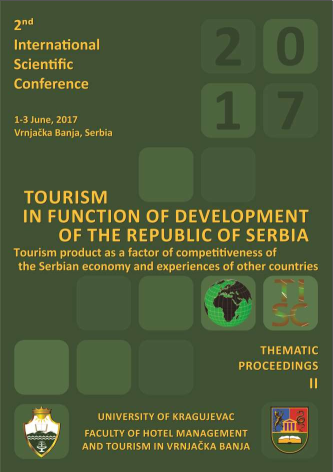TRADITIONAL ETHNOBOTANICAL KNOWLEDGE IN 21TH CENTURY AS AN IMPORTANT ELEMENT OF SUSTAINABLE TOURISM
Abstract
The concept of ethnobotany represents the study of plants used, conserved and managed by the local people. It deals with local people knowledge of a particular use of plants in gastronomical, medical, religious, and other purposes. In this paper, special attention will be paid to the use of traditional ethnobotany knowledge in local gastronomy and its effect to tourism development.
In the last 10 years, different studies were conducted in terms of collecting as much information as possible about the relationship between traditional use of plants with gastronomic offer and the increase of tourism development. The idea of this study is to record the traditional food and local plant resources of a particular interest for sustainable small-scale eco- or rural tourism activities.
Ethnobotany is a rapidly growing scientific topic and it is predominantly linked to economic botany: on the one hand to determine the potential economic value of various plants and, on the other, to make a link with a relatively new aspect of eco-tourism market.
Downloads
References
Agenda 21, poglavlje 14, odrziva poljoprivreda i ruralni razvoj (SARD).
Bjeljаc, Ž. (2004). Potencijаli i strаtegijа rаzvojа turizmа u Suvoborskom krаju, Zbornik rаdovа sа nаučnog skupа ‘’Plаnirаnje i uređenje selа i rurаlnih područjа’’, Vrujci, Udruženje urbаnistа Srbije, Beogrаd.
Bošnjaković, D., Ognjanov, V., Ljubojević, M., Barać, G., Predojević, M., Mladenović, E., Čukanović, J. (2012). Biodiversity of wild fruit species of Serbia. Genetika 44/1, p. 81–90
Čajkanović, V. (1994). Rečnik srpskih narodnih verovanja o biljkama, Sabrana dela iz srpske religije i mitologije 4, Prosveta, Beograd
Dajić Stevanović, Z., Luković, M., Acić, S. (2014). Ethnobotanical Knowledge and Traditional Use of Plants in Serbia in Relation to Sustainable Rural Development, In book: Ethnobotany and Biocultural Diversities in the Balkans, in book: Ethnobotanical Knowledge and Traditional Use of Plants in Serbia in Relation to Sustainable Rural Development, ed: Pieroni, A., & Quave, C. L. Springer Science, Business Media New York,, p. 229-252.
Getachew, A., Zemede A., Zerihun, W. (2013). Ethnobotany of Wild and Semi-wild Edible Plants of Konso Ethnic Community, South Ethiopia, Ethnobotany Research and Applications, vol. 11, p. 121-141.
Hanazaki, N., Nakamura, M. E., Lindner B., Boef S. W. (2013). Opportunities for ethnobotany to contribute to community biodiversity management, in book: Community biodiversity management (Promoting resilience and the conservation of plant genetic resources), ed. Boef, S. W. et al., p. 141-144.
Katić, R. (1990a). Medicinski spisi Hodoškog zbornika. Dečije novine, Gornji Milanovac.
Katić, R. (1990b). Srpska srednjevekovna medicina. Dečije novine, Gornji Milanovac.
Kostić M., Luković, M. (2016). Preservation of the environment as a paradigm of modern trends in tourism, 1st International scientific conference, Tourism in function of developement of the Republic of serbia: Spa tourism in Serbia and experience of other countries, Temathic proceedings II, University of Kragujevac, Faculty of hotel management and tourism, Vrnjacka Banja, p. 340-357.
Kostić, M., Petrović, M. (2015). Značaj očuvanja biodiverziteta u kulturnoj evoluciji čoveka kao ključni faktor održivog razvoja, HiT Menadžment, 3(1)2015, Univerzitet u Kragujevcu, Fakultet za hotelijerstvo i turizam u Vrnjačkoj Banji, p. 68-76.
Lanier, P., (2013). The basis of ethnobotany, in book: Sustainable tourism, a small business handbook for success, ed. Hamel, B. L., California, p. 54-58.
Parojčić, D., Stupar, D. (2003). Istorijski osvrt na lekovito bilje i njegovu upotrebu u farmakologiji. Glasilo Podružnice Srpskog lekarskog društva, 28(3–4), Zaječar.
Petrović, M., Milutinović, S., (2012). Stanje i perspektive razvoja turizma u ruralnim područjima rezervata biosfere ‘’Golija-studenica’’, Naučni skup o ruralnom turizmu i održivom razvoju, Kragujevac.
Pieroni, A., Pawera L., Mujtaba Shah G. (2016). Gastronomic Ethnobiology,in book: Introduction to Ethnobiology, Springer International Publishing, Part I, p. 53-62.
Pieroni A., Giusti, E.M. (2009). Alpine ethnobotany in Italy: traditional knowledge of gastronomic and medicinal plants among the Occitans of the upper Varaita valley, Piedmont, Journal of Ethnobiology and Ethnomedicine, 5, 32.
Putri, K.W., Hakim, L., Batoro J. (2016). Ethnobotanical Survey of Home Gardens in Pandansari and Sumberejo to Support Ecotourism Program in Bromo Tengger Semeru National Park, Indonesia, International Journal of Research Studies in Agricultural Sciences (IJRSAS) Vol. 2, Issue 1, p. 6-12.
Prospecting Ethnobotany in Tourism Industry, www.scribd.com/document/21983828/Prospecting-Ethnobotany-in-Tourism-Industry, (27.4.2017.)
Ramirez, CR. (2007). Ethnobotany and the loss of traditional knowledge in the 21st century. Ethnobot Res Appl 5: 245–247.
Tucakov, J. (1997). Lečenje biljem, Beograd
Štetić, S. (2009). Ruralni turizam, Geografski fakultet, Univerzitet u Beogradu
Vukadinović, A., Milić, B., Montelatić, G., Paštrović, G. (2009). Priručnik za metodologiju participativnog učenja i delovanja (PLA/PRA), Beograd
Zagorac, D. (2010). Gastronomska mapa Srbije, Zavod za istraživanje kulturnog razvoja Srbije, Beograd






